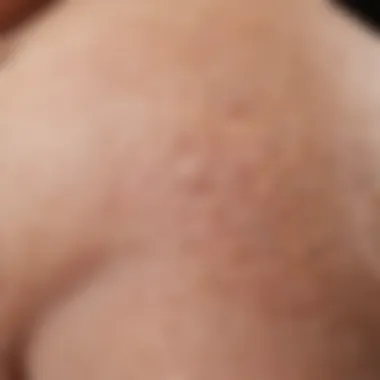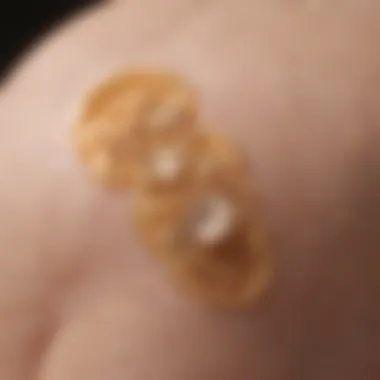Effective Treatment Creams for Keratosis Pilaris


Intro
Keratosis pilaris, often referred to as KP, is a prevalent skin condition that affects many individuals, particularly women. This disorder leads to small, rough bumps on the skin, commonly appearing on areas like the arms, thighs, and even the face. Despite being harmless, this condition can cause dissatisfaction with skin appearance and texture. Consequently, many search for effective treatments to improve their skin.
This guide focuses on treatment creams specifically designed for keratosis pilaris. We will explore various active ingredients, delve into their mechanisms of action, application techniques, and share user experiences to provide a well-rounded understanding of how to manage this condition through topical therapies.
In addition to outlining effective treatment options, this article will also touch upon relevant skincare practices suitable for different skin types. Along the way, we aim to enhance your knowledge and empower you to make informed choices regarding your skin health.
As we proceed, you will find practical tips, product suggestions, and techniques that accommodate the unique needs of women of all ages. Let's begin by discussing effective skincare routines to manage keratosis pilaris effectively.
Understanding Keratosis Pilaris
Understanding keratosis pilaris is a key element in addressing this common skin condition. By gaining knowledge about what it is, its underlying causes, and how it manifests, individuals can make informed decisions regarding treatment. This section serves as a foundation for the subsequent discussions on treatment options, as it places emphasis on the importance of recognizing and understanding the condition itself.
Definition of Keratosis Pilaris
Keratosis pilaris, often referred to as "chicken skin," is a benign skin condition characterized by small, rough bumps on the skin's surface. These bumps are typically caused by the accumulation of keratin, a natural protein found in the skin. This buildup leads to clogged hair follicles, resulting in a textured appearance on certain areas of the body, most commonly the arms, thighs, and face. While keratosis pilaris poses no health risks, its cosmetic impact can be bothersome for many individuals.
Causes of Keratosis Pilaris
The exact cause of keratosis pilaris is not definitively known, but several factors contribute to its development. Genetics plays a significant role; if a family member has it, there is a higher chance of occurring in others. Additionally, keratosis pilaris is more prevalent among individuals with dry skin, eczema, or other skin conditions. Hormonal changes, particularly during puberty or pregnancy, can exacerbate its appearance, leading to flare-ups.
Symptoms and Diagnosis
Keratosis pilaris is generally identified by the presence of small, red or skin-colored bumps on the skin. These bumps may feel dry or rough to the touch. While the bumps are harmless, they can sometimes be itchy or irritating, which may draw individuals to seek treatment. Diagnosis is typically straightforward and can often be made during a physical examination by a dermatologist. However, if there are concerns about other skin conditions, a biopsy may be performed to rule out alternative diagnoses. Regular check-ups can also be beneficial for monitoring skin health.
"Keratosis pilaris, while not harmful, can impact self-esteem, making understanding and treatment desirable for many."
In summary, understanding keratosis pilaris is essential for anyone experiencing this skin condition. Awareness of its definition, causes, and symptoms equips individuals with the knowledge needed to take appropriate action toward improving skin texture and overall confidence.
The Role of Treatment Creams
Understanding the role of treatment creams in managing keratosis pilaris is essential for individuals looking to improve their skin's appearance. These topical treatments serve as a primary line of defense against the symptoms associated with this common skin condition. By addressing the causes and effects of keratosis pilaris, treatment creams can significantly enhance skin texture and reduce the visibility of bumpy skin.
Topical treatments offer various benefits. They are often easy to apply and can be incorporated into typical skincare routines. Moreover, many creams contain active ingredients aimed at exfoliating dead skin cells and unclogging hair follicles. This mechanism is crucial for preventing the formation of bumps that characterize keratosis pilaris.
While many people look for quick fixes, it is important to choose products that suit individual skin types. Therefore, knowledge about different treatment options and their active components is vital.
Importance of Topical Treatments
Topical treatments are significant in addressing keratosis pilaris because they deliver active ingredients directly to the area of concern. This delivery method allows for targeted action. For instance, creams formulated with alpha hydroxy acids can exfoliate the skin surface and improve its overall smoothness. It helps in breaking down the build-up of keratin, which is responsible for the bumps in keratosis pilaris.
Additionally, using topicals can lead to fewer side effects compared to systemic treatments. Most topical applications have a lower chance of causing widespread reactions, making them ideal for managing localized skin issues like keratosis pilaris.
Comparing Treatment Options
When looking for treatment options for keratosis pilaris, individuals often find themselves navigating between prescription and over-the-counter creams. Both categories have merits and can be effective.
Prescription vs Over-the-Counter Creams
The distinction between prescription and over-the-counter creams largely revolves around strength and concentration. Prescription creams typically contain higher concentrations of active ingredients like retinoids or stronger exfoliating agents. This characteristic makes them a popular choice for more severe cases of keratosis pilaris.
On the other hand, over-the-counter options are accessible without a prescription, making them a convenient choice for daily maintenance and milder symptoms. Many people find them effective in managing their condition over time without the need for more potent medications.
However, it is crucial to recognize that while over-the-counter creams may provide comfort and gradual improvement, those with more persistent symptoms might need to consider prescription alternatives.
Natural Remedies vs Pharmaceutical Options


Natural remedies have gained traction as alternatives to pharmaceutical treatments. They often include ingredients like coconut oil or tea tree oil, which are known for their moisturizing and anti-inflammatory properties. Natural remedies appeal to those who prefer gentler, more holistic approaches to skincare.
While these treatments can be beneficial for some individuals, their effectiveness may vary. Pharmaceutical options tend to have scientifically backed results and are often faster in alleviating symptoms. Each type has its unique features and benefits, but potential users should weigh the pros and cons carefully.
In deciding between remedies, one should consider skin sensitivity, ease of application, and personal preferences. Ultimately, whether one chooses natural remedies or pharmaceutical options, an informed decision can significantly contribute to managing keratosis pilaris effectively.
Active Ingredients in Treatment Creams
Active ingredients in treatment creams play a critical role in managing keratosis pilaris. These ingredients are formulated to address the underlying causes of the condition, such as excess keratin buildup and skin texture irregularities. Understanding these active components can enhance the effectiveness of treatment creams and tailor the application to individual skin needs.
Alpha Hydroxy Acids (AHAs)
Alpha Hydroxy Acids are water-soluble acids derived from fruits and milk. Common types include glycolic acid and lactic acid. AHAs exfoliate the skin's surface by dissolving the bonds between dead skin cells, which helps to unclog hair follicles and minimize the appearance of bumps associated with keratosis pilaris. Using AHAs can promote smoother skin and enhance overall texture.
Benefits of AHAs:
- Exfoliation: They help in gentle exfoliation, which is crucial for removing dead skin cells.
- Moisturizing: AHAs also have hydrating properties, aiding in maintaining skin moisture balance.
Beta Hydroxy Acids (BHAs)
Beta Hydroxy Acids, like salicylic acid, are oil-soluble and penetrate deeper into the pores. This makes BHAs effective in treating keratosis pilaris, particularly for individuals with oily or acne-prone skin. They target clogged pores by breaking down sebum and dead skin cells, leading to clearer and smoother skin.
Key Considerations:
- Oil-Solubility: BHAs can reach deeper layers of the skin, adding another layer of efficacy in reducing keratin buildup.
- Anti-Inflammatory: Many find that salicylic acid has soothing properties, making it suitable for sensitive skin.
Urea and Lactic Acid
Urea is a natural component of the skin that helps to retain moisture, while lactic acid, an AHA, also provides exfoliation. Together, they work synergistically to soften rough patches associated with keratosis pilaris. Urea has an additional benefit of aiding in skin hydration, while lactic acid encourages cell turnover.
Combining Both:
- Urea attracts moisture to the skin.
- Lactic acid exfoliates and smooths the skin surface, resulting in a dual action for better management of keratosis pilaris.
Retinoids
Retinoids like tretinoin and adapalene are derived from vitamin A and are well known for their effectiveness in treating various skin conditions. They promote rapid cell turnover and prevent the buildup of keratin in hair follicles, which is central to managing keratosis pilaris. Retinoids can also help in improving skin texture and reducing pigmentation.
Important Notes:
- Adjusting Expectations: While effective, retinoids may cause initial peeling and irritation, requiring gradual introduction into a skincare routine.
- Prescription Need: Some stronger forms may require a prescription, which can be beneficial for severe cases.
Moisturizers and Emollients
Moisturizers and emollients are essential for treating keratosis pilaris, as they create a protective barrier and retain hydration. These products help to alleviate the dryness often associated with the condition. Ingredients such as shea butter, glycerin, and ceramides are effective at soothing rough patches and preventing moisture loss.
Why They Matter:
- Barrier Function: They improve the skin barrier function, which is critical for maintaining smooth skin.
- Skin Soothing: Many ingredients within this category help to reduce inflammation and irritation, which can arise from using active treatment creams.
"Selecting the right active ingredients tailored to your skin will significantly impact the effectiveness of keratosis pilaris treatment creams."
In summary, a thorough understanding of active ingredients in treatment creams for keratosis pilaris will empower individuals to make informed decisions. This knowledge supports a comprehensive approach to skincare, promoting healthier skin and increased confidence.
Popular Keratosis Pilaris Treatment Creams
Keratosis pilaris, with its hallmark rough bumps, often leaves individuals seeking effective resolutions. Within this context, kematosis pilaris treatment creams become essential. These products aim to not only alleviate visible symptoms but also enhance the overall skin texture. A variety of treatments exist, catering to different preferences and skin types. Understanding these options can empower individuals to choose the most suitable product for their skin needs.
Leading OTC Options


Over-the-counter (OTC) treatment creams provide accessible solutions for many experiencing keratosis pilaris. Products containing alpha hydroxy acids, such as glycolic acid, are frequently recommended. These creams assist in exfoliating the upper layer of skin, thereby reducing the appearance of bumps. Similarly, those with salicylic acid can penetrate deeply, further refining the skin texture.
Among the popular leading OTC creams, formulations from CeraVe, Eucerin, and Ameliorate earn high marks for effectiveness and user satisfaction. Users note that these creams offer noticeable improvements in skin smoothness after consistent application. Often, these treatments are designed to be paired with moisturizers to ensure sufficient hydration, which is critical for optimal results.
Prescription Treatments Overview
For some, OTC treatments may not provide adequate relief. In such cases, prescription treatments are available that often include more potent active ingredients. For instance, creams containing retinoids, such as Tretinoin, can help normalize skin cell turnover. Regular use may lead to significant improvements in the texture and appearance of the skin.
Additionally, dermatologists sometimes prescribe stronger formulations of urea-based creams. These creams not only exfoliate but also help in retaining moisture, thereby softening the bumps associated with keratosis pilaris. Overall, prescription options should be considered after consulting with a healthcare professional, ensuring a tailored approach based on individual skin needs.
Luxury vs Budget Creams
The market for keratosis pilaris treatment creams presents a diverse range of products, from budget-friendly options to luxury brands. Budget creams, often containing similar active ingredients, can provide effective results without the hefty price tag. Brands like Nivea and Neutrogena make creams that are affordable without compromising on quality.
On the other hand, luxury creams often emphasize superior formulations with additional benefits, such as added vitamins or unique hydrating elements. Brands like La Roche-Posay and SkinCeuticals often come at a premium price but may yield faster or more pronounced results. Ultimately, the decision between luxury versus budget creams differs among individuals. Factors such as skin sensitivity, effectiveness, and personal preference play significant roles in this decision.
The value of effective treatment for keratosis pilaris cannot be overstated. Achieving smoother skin is often a goal for many. Individual experiences can vary; some may find significant relief with a budget product, while others may seek higher-end formulations. Regardless of the choice, understanding the differences in product formulations and effectiveness can guide informed decisions.
Application Techniques for Best Results
When dealing with keratosis pilaris, the way treatment creams are applied can significantly affect their efficacy. Understanding the proper application techniques is essential for achieving the best results. This section will discuss important aspects such as the frequency of application, how to layer treatment creams with other skincare products, and the overall timing of moisturization. Each of these elements plays a crucial role in managing keratosis pilaris effectively, ensuring both comfort and effectiveness in your skincare routine.
Frequency of Application
Regularity in application is vital for any topical treatment to be effective. For keratosis pilaris, most dermatologists recommend applying treatment creams at least once a day. However, it might be beneficial to use them more than once daily if the skin tolerates the formulation well. Consistency not only promotes skin cell turnover, which is often disrupted in keratosis pilaris, but also helps diminish the appearance of rough bumps over time.
While starting a new cream, a patch test is advisable to ensure there are no adverse reactions. If irritation occurs, it's wise to decrease the frequency gradually.
"Slow and steady wins the race in treating keratosis pilaris. Maintain a routine for the best results."
Layering with Other Skincare Products
When using treatment creams, the order in which products are applied matters. Generally, treatment creams should be applied to clean, dry skin before the application of other moisturizers or serums. This helps the active ingredients penetrate deeper into the skin for better results. Important considerations include:
- Cleanse: Always wash your skin gently to remove impurities before applying any product.
- Allow Absorption: Let the treatment cream absorb for a few minutes before layering other products.
- Moisturizer: Follow with a gentle moisturizer to seal in hydration. This also helps combat any dryness or irritation that may arise from potent active ingredients.
When to Moisturize
Moisturizing should be part of your daily skincare routine, particularly after applying treatment creams. The specific timing can vary based on the product used. It's typically recommended to apply a moisturizer after the treatment cream has absorbed. This helps to keep the skin hydrated and reduces any potential irritation from the active ingredients.
- Use a moisturizer itself containing hydrating agents, like hyaluronic acid or glycerin, to enhance the effect of treatment creams.
- Pay attention to how your skin feels. If it leads to excessive dryness, adjusting the type of moisturizer or adding a separate hydrating serum could be beneficial.
In summary, applying keratosis pilaris treatment creams effectively includes understanding the frequency, proper layering, and timely moisturization. These techniques collectively enhance the impact of the creams, making management of keratosis pilaris more accessible and effective.
Potential Side Effects and Considerations
When exploring the treatment options for keratosis pilaris, it is crucial to understand the potential side effects that may arise from the use of topical creams. Though treatment creams often provide desirable results, they can also induce adverse reactions. Being aware of these aspects will aid individuals in making informed decisions while selecting the right product for their skin. Additionally, understanding the importance of proper application and conservative use can further enhance the treatment experience, mitigating risks.
Common Side Effects
Some common side effects associated with keratosis pilaris treatment creams may affect many users. These can include:
- Skin irritation: This can manifest as redness, itching, or a burning sensation. Irritation is particularly common when starting a new cream or using a product with strong active ingredients.
- Dryness: Many active components, such as alpha hydroxy acids, can lead to excessive dryness. This may require adjusting the frequency of application or incorporating additional moisturizers.
- Peeling: Some users might experience peeling skin, especially with retinoids or strong exfoliating agents.
It is essential to monitor reactions during the initial usage period. Gradually introducing a cream can ease the skin into the acceptance of new active ingredients.
"Listening to your skin is necessary. If irritation occurs, it may be wise to discontinue use or consult a dermatologist."


Skin Sensitivity Considerations
Skin type plays a significant role in how individuals react to treatment creams. Those with sensitive skin should consider the following:
- Patch testing: Always perform a patch test before applying new products to larger areas. This helps to identify any adverse reactions without affecting a significant portion of the skin.
- Formulation choices: Look for formulas labeled as hypoallergenic or suitable for sensitive skin to minimize the risk of irritation.
- Avoiding harsh ingredients: Some active ingredients may irritate already sensitive skin. Individuals should choose milder options that still address keratosis pilaris without provoking sensitivity.
Interactions with Other Treatments
Keratosis pilaris treatment creams can interact with other skincare products, which may alter their efficiency or lead to side effects. Consider these interactions:
- Combining active ingredients: Certain ingredients, like retinoids or acids, should not be layered with other potent actives to avoid irritation or dryness.
- Concurrent treatments: If using other treatments for conditions like acne or eczema, it is crucial to ensure they do not conflict with keratosis pilaris treatments.
- Consulting a dermatologist: Individuals are advised to discuss their entire skincare routine with a dermatologist, especially when incorporating new treatments. This can help avoid conflicts and ensure optimal results.
By being aware of these potential side effects and considerations, individuals can navigate the treatment landscape more effectively. Ultimately, a personalized approach will contribute to better management of keratosis pilaris.
User Experiences and Testimonials
User experiences and testimonials provide valuable insights into the effectiveness of various keratosis pilaris treatment creams. They represent the voices of real individuals who have navigated their relationship with this skin condition and the treatments available. These personal accounts can help others in their quest to manage keratosis pilaris effectively.
Understanding user experiences is crucial for several reasons. First, they highlight the practical outcomes of different treatments. While clinical data offers statistical success rates, individual stories shed light on daily realities. Users may face challenges that clinical trials do not address, such as ease of application, odor, or sensation during use.
Second, testimonials can reveal trends in effectiveness. Certain ingredients or brands may repeatedly surface in positive reviews, indicating a consensus among users. This collective feedback can guide prospective users toward optimal choices, thereby saving time and potentially reducing trial and error.
Finally, reading about others' journeys can foster a sense of community. When individuals realize they are not alone in managing keratosis pilaris, it can provide reassurance. This can be particularly helpful in a condition often perceived as cosmetic rather than medical. Given these factors, user experiences are an essential component of understanding treatment options.
Effectiveness of Different Creams
The effectiveness of keratosis pilaris treatment creams varies widely among users. Generally, creams containing alpha hydroxy acids or retinoids are often mentioned favorably. These active ingredients help exfoliate the skin and reduce the buildup of keratin that causes the bumps associated with keratosis pilaris.
Many users report a noticeable improvement in skin texture after consistent application of these creams. Results may manifest as smoother skin and reduced redness. However, effectiveness can depend on skin type, sensitivity, and adherence to a routine.
Some users find success with over-the-counter options like AmLactin or CeraVe. These creams seem to be particularly effective when combined with good moisturizing practices. Others, however, may require prescription treatments, which can be more potent but also potentially irritate sensitive skin.
"I tried so many products until I found AmLactin. Within a few weeks, my skin felt less rough and looked clearer," shared one user who had struggled with keratosis pilaris for many years.
While individual testimonials vary, recurring themes emphasize the importance of patience. Many users underline that visible improvements typically take time. Consistent application is crucial; skipping days can hinder progress.
Long-Term Results and Maintenance
Long-term results from keratosis pilaris treatments often hinge upon ongoing maintenance. Once an individual achieves their desired results, it becomes critical to establish a long-term skincare routine. Some users find that reducing frequency can still maintain results, while others prefer to stick with their regular regimen.
Several testimonials suggest that a combination of treatments can lead to better outcomes. For example, users often mention pairing topical creams with gentle exfoliating scrubs or routines that include regular moisturizing. This comprehensive approach addresses the condition from multiple angles.
Users also advocate the importance of monitoring skin response. Some individuals may find their skin becomes immune to certain products over time, necessitating a switch. This can mean alternating between creams with different active ingredients to continuously stimulate skin improvement.
In summary, long-term results are promising but depend on individual commitment. Case studies reveal that those who maintain a proactive approach to their skincare can enjoy sustained benefits, keeping keratosis pilaris at bay for years to come.
The End and Recommendations
The conclusion is a crucial section of this article, encapsulating the essence of what has been discussed regarding keratosis pilaris treatment creams. This skin condition, while mostly benign, can significantly affect one's confidence and comfort. Therefore, understanding how to manage it effectively is of paramount importance.
In summarizing the journey through treatment options, it becomes evident that a detailed knowledge of the available products, their active ingredients, and application techniques contributes to more effective management of keratosis pilaris. Readers should recognize that individual skin types vary, and what works well for one person might not yield the same results for another. Evaluating one’s skin condition, consulting healthcare providers, and observing any reactions to products is necessary for safe application.
The benefits of using targeted treatment creams include improved skin texture, reduction of bumps, and overall skin health enhancement.
Key Takeaways
- Understanding Treatment Options: Knowledge of both over-the-counter and prescription options allows for a tailored approach to treatment.
- Ingredient Awareness: Familiarity with active ingredients such as AHAs, BHAs, and retinoids empowers users to select a more effective cream suited to their skin.
- Importance of Consistency: Regular application is often key to seeing results. Consistency can enhance the effectiveness of any treatment chosen.
- Potential Side Effects: Being aware of common side effects and skin sensitivity can help avoid complications.
- User Experiences: Listening to testimonials and experiences from others can provide realistic insights on what can be expected from treatment.
Final Thoughts on Treatment Options
In closing, while keratosis pilaris can be a persistent issue, numerous treatment creams can help manage its symptoms. Each user should approach treatment with patience and an understanding of their unique skin needs. The road to smooth skin may require some trial and error, but it is possible with the right information and resources.
For those exploring these treatment options, consulting with a dermatologist can provide personalized recommendations. Investing time in research and applying insights from this guide can contribute significantly toward finding an effective solution and ultimately achieving the desired skin texture.
For anyone feeling frustrated by keratosis pilaris, remember that patience and persistence in treatment can lead to significant improvements.







